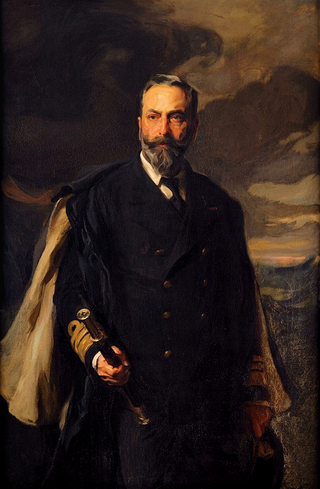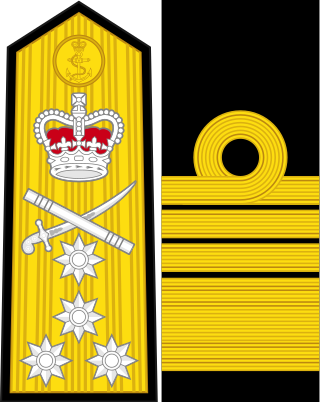Related Research Articles

The Admiralty was a department of the Government of the United Kingdom responsible for the command of the Royal Navy until 1964, historically under its titular head, the Lord High Admiral – one of the Great Officers of State. For much of its history, from the early 18th century until its abolition, the role of the Lord High Admiral was almost invariably put "in commission" and exercised by the Lords Commissioner of the Admiralty, who sat on the governing Board of Admiralty, rather than by a single person. The Admiralty was replaced by the Admiralty Board in 1964, as part of the reforms that created the Ministry of Defence and its Navy Department.

Admiral of the Fleet Sir Frederick Charles Doveton Sturdee, 1st Baronet was a Royal Navy officer. After training as a torpedo officer, he commanded two different cruisers and then three different battleships before becoming commander of the 1st Battle Squadron of the Home Fleet. He went on to command the 3rd Cruiser Squadron and then the 2nd Cruiser Squadron.

Louis Alexander Mountbatten, 1st Marquess of Milford Haven, formerly Prince Louis Alexander of Battenberg, was a British naval officer and German prince related by marriage to the British royal family.

Admiral of the Fleet is a five-star naval officer rank and the highest rank of the Royal Navy, formally established in 1688. The five-star NATO rank code is OF-10, equivalent to a field marshal in the British Army or a Marshal of the Royal Air Force. Apart from honorary appointments, no new admirals of the fleet have been named since 1995, and no honorary appointments have been made since 2014.

The First Sea Lord and Chief of the Naval Staff (1SL/CNS) is a statutory position in the British Armed Forces usually held by a four star admiral. As the highest-ranking officer to serve in the Royal Navy, the chief is the principal military advisor on matters pertaining to the navy and a deputy to the Secretary of State for Defence. In a separate capacity, the CNS is a member of the Chiefs of Staff Committee and, thereby, a military advisor to the National Security Council, the prime minister and the monarch. The First Sea Lord is typically the highest-ranking officer on active duty of the Royal Navy unless the Chief of the Defence Staff is a naval officer. Admiral Ben Key was appointed First Sea Lord in November 2021.

Admiral of the Fleet John Arbuthnot Fisher, 1st Baron Fisher,, commonly known as Jacky or Jackie Fisher, was a British Admiral of the Fleet. With more than sixty years in the Royal Navy, his efforts to reform the service helped to usher in an era of modernisation which saw the supersession of wooden sailing ships armed with muzzle-loading cannon by steel-hulled battlecruisers, submarines and the first aircraft carriers.

The British Mediterranean Fleet, also known as the Mediterranean Station, was a formation of the Royal Navy. The Fleet was one of the most prestigious commands in the navy for the majority of its history, defending the vital sea link between the United Kingdom and the majority of the British Empire in the Eastern Hemisphere. The first Commander-in-Chief for the Mediterranean Fleet was the appointment of General at Sea Robert Blake in September 1654. The Fleet was in existence until 1967.

Admiral is a senior rank of the Royal Navy, which equates to the NATO rank code OF-9, outranked only by the rank of admiral of the fleet. Royal Navy officers holding the ranks of rear admiral, vice admiral and admiral of the fleet are sometimes considered generically to be admirals. The rank of admiral is currently the highest rank to which a serving officer in the Royal Navy can be promoted, admiral of the fleet being in abeyance except for honorary promotions of retired officers and members of the Royal Family.
The Naval Laws were five separate laws passed by the German Empire, in 1898, 1900, 1906, 1908, and 1912. These acts, championed by Kaiser Wilhelm II and his Secretary of State for the Navy, Grand Admiral Alfred von Tirpitz, committed Germany to building up a navy capable of competing with the Royal Navy of the United Kingdom.

Vice-Admiral of the Blue was a senior rank of the Royal Navy of the United Kingdom, immediately outranked by the rank Vice-Admiral of the White. Royal Navy officers currently holding the ranks of commodore, rear admiral, vice admiral and admiral of the fleet are sometimes considered generically to be admirals. From 1688 to 1805 this rank was in order of precedence sixth; after 1805 it was the seventh. In 1864 it was abolished as a promotional rank. The command flag for a Vice-Admiral of the Blue is pictured opposite.

The Royal Naval College, Osborne, was a training college for Royal Navy officer cadets on the Osborne House estate, Isle of Wight, established in 1903 and closed in 1921.

Rear-Admiral of the Blue was a senior rank of the Royal Navy of the United Kingdom, immediately outranked by the rank Rear-Admiral of the White. Royal Navy officers currently holding the ranks of commodore, rear admiral, vice admiral and admiral of the fleet are sometimes considered generically to be admirals. From 1688 to 1805 this rank was in order of precedence ninth; after 1805 it was the tenth. In 1864 it was abolished as a promotional rank.

Rear-Admiral of the White was a senior rank of the Royal Navy of the United Kingdom, immediately outranked by the rank Rear-admiral of the red. Royal Navy officers currently holding the ranks of commodore, rear admiral, vice admiral and admiral of the fleet are sometimes considered generically to be admirals. From 1688 to 1805 this rank was in order of precedence eighth; after 1805 it was the ninth. In 1864 it was abolished as a promotional rank..

The First Lord of the Admiralty, or formally the Office of the First Lord of the Admiralty, was the political head of the English and later British Royal Navy. He was the government's senior adviser on all naval affairs, responsible for the direction and control of the Admiralty, and also of general administration of the Naval Service of the Kingdom of England, Great Britain in the 18th century, and then the United Kingdom, including the Royal Navy, the Royal Marines, and other services. It was one of the earliest known permanent government posts. Apart from being the political head of the Naval Service the post holder was simultaneously the pre-eminent member of the Board of Admiralty. The office of First Lord of the Admiralty existed from 1628 until it was abolished when the Admiralty, Air Ministry, Ministry of Defence and War Office were all merged to form the new Ministry of Defence in 1964. Its modern-day equivalent is the Secretary of State for Defence.

Rear-Admiral of the Red was a senior rank of the Royal Navy of the United Kingdom, immediately outranked by the rank Vice-Admiral of the Blue. Royal Navy officers currently holding the ranks of commodore, rear admiral, vice admiral and admiral of the fleet are sometimes considered generically to be admirals. From 1688 to 1805 this rank was in order of precedence seventh; after 1805 it was the eighth. In 1864 it was abolished as a promotional rank..

Vice-Admiral of the Red was a senior rank of the Royal Navy of the United Kingdom, immediately outranked by the rank admiral of the Blue. Royal Navy officers currently holding the ranks of commodore, rear admiral, vice admiral and admiral of the fleet are sometimes considered generically to be admirals. From 1688 to 1805 this rank was in order of precedence fourth; after 1805 it was the fifth. In 1864 it was abolished as a promotional rank..

The High Seas Fleet was the battle fleet of the German Imperial Navy and saw action during the First World War. The formation was created in February 1907, when the Home Fleet was renamed as the High Seas Fleet. Admiral Alfred von Tirpitz was the architect of the fleet; he envisioned a force powerful enough to challenge the Royal Navy's predominance. Kaiser Wilhelm II, the German Emperor, championed the fleet as the instrument by which he would seize overseas possessions and make Germany a global power. By concentrating a powerful battle fleet in the North Sea while the Royal Navy was required to disperse its forces around the British Empire, Tirpitz believed Germany could achieve a balance of force that could seriously damage British naval hegemony. This was the heart of Tirpitz's "Risk Theory", which held that Britain would not challenge Germany if the latter's fleet posed such a significant threat to its own.

Vice-Admiral of the White was a senior rank of the Royal Navy of the United Kingdom, immediately outranked by the rank Vice-Admiral of the Red. Royal Navy officers holding the ranks of commodore, rear admiral, vice admiral and admiral of the fleet are sometimes considered generically to be admirals. From 1688 to 1805, this rank was fifth in order of precedence; after 1805, it was the sixth. In 1864, it was abolished as a promotional rank.

Admiral of the Red was a senior rank of the Royal Navy of the United Kingdom, immediately outranked by the rank Admiral of the Fleet. The rank did not exist prior to 1805, as the admiral commanding the Red squadron was called Admiral of the Fleet. When the duties of Admiral of the Fleet were separated from Red squadron in 1805, the Admiral of the Red was created, and until 1864 this rank was the second highest rank in order of precedence. In 1864 it was abolished as a promotional rank.

Admiral of the White was a senior rank of the Royal Navy of the United Kingdom, immediately outranked by the rank Admiral of the Red. From 1688 to 1805 this rank was in order of precedence second; after 1805 it was the third. In 1864 it was abolished as a promotional rank.
References
- ↑ Stroud Francis Charles Milsom (2003), "Management, Custom, and Law", A Natural History of the Common Law, Columbia University Press, p. 54, ISBN 9780231129947
- ↑ John Arbuthnot Fisher Baron Fisher (1953), Arthur Jacob Marder (ed.), Fear God and Dread Nought: The Correspondence of Admiral of the Fleet Lord Fisher of Kilverstone, vol. 1, Jonathan Cape, p. 181
- ↑ Alastair Fowler (2012), Literary Names: Personal Names in English Literature, Oxford University Press, p. 39, ISBN 9780191650994